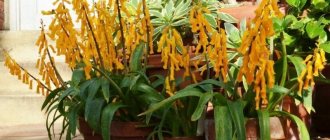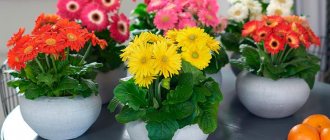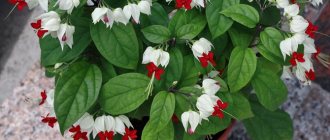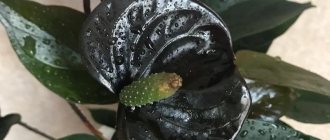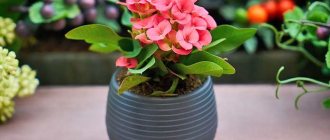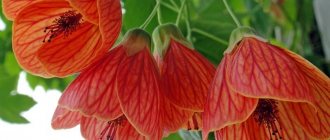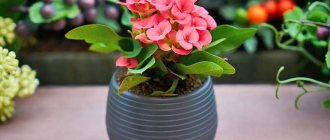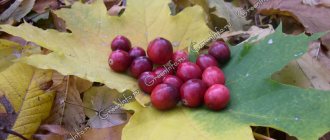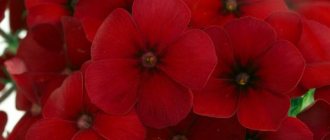What is special about these flowers?
Yellow houseplants have a variety of lovers. And this is no coincidence, because these flowers have a number of advantages over others:
- bright and sunny colors make the atmosphere of the house solemn;
- improve the well-being and cheer up the owners;
- Most of these plants not only have bright flower colors, but also beautiful leaves.
In addition to the listed benefits, yellow flowers have all the properties of other indoor plants. They humidify the air, saturate it with oxygen, protect against electromagnetic radiation and some viruses.
Blooming species with photos and names
Pay attention to a number of examples of unpretentious indoor plants with yellow flowers that even a novice gardener can handle. In response, they will certainly delight you with beautiful flowering:
Maple abutilone. This plant belongs to the mallow family and has maple-like leaves. It is characterized by brightly colored bell-shaped flowers, including yellow ones. The main thing it needs is regular watering. If this condition is met, abutilon can bloom until late autumn, and sometimes in winter.
Pachistachis yellow. It is an evergreen shrub up to 1 m tall with large dark green leaves. Its beautiful appearance is achieved not due to the flowers - they are white and rather inconspicuous, but thanks to the bright and unusual yellow bracts. They are the ones who maintain the decorative appearance of the Pakistani for several months
.
Common primrose. Several hundred plant species belong to the primrose genus. One of the most popular is the common primrose, which can grow both in open ground and in an apartment. It does not require complex care and grows well even with inexperienced gardeners. Blooming in early spring, the primrose is considered a primrose, and its bright yellow flowers symbolize the sun and the awakening of nature
.
Kalanchoe. Flowering begins at the end of winter and lasts about a month. The flowers come in yellow, white, red or purple umbels. In addition to its attractive appearance, Kalanchoe has a number of medicinal properties. Disinfects, stops bleeding, relieves inflammation and heals wounds
Yellow terry begonia. The love of flower growers is deserved by the ease of care and incredible beauty of lemon-yellow flowers, similar to roses and with a pleasant aroma. Florists often use it to decorate weddings and other events. Flowering continues for a long time, under favorable conditions, from May to early November. Begonia grows equally well in pots on the windowsill and in hanging pots or boxes on the balcony
Peculiarities! The popular name for begonia is a flower that purifies the air. Excellent removal of toxic compounds and dust.
Indoor yellow flowers are beautiful and varied. They look great both individually and in combination with flowers of other shades. Each gardener can choose a plant according to his taste.
Yellow chrysanthemums
They bloom in the cold season. These fluffy chicken-like creatures will bring warmth and joy to your home.
The feeling of joy will intensify if you place vases with chrysanthemums (or vases with bouquets) in opposite corners of the room, and place mirrors behind them.
Achimenes
A beautiful plant with bright green velvety leaves with smooth, neat teeth along the edges and soft yellow flowers.
Clivia
Beautiful flowers on which large inflorescences open - umbrellas consisting of 15 or more flowers of golden or fiery orange color.
They look fresh against the background of large dark emerald leaves collected in a rosette. Clivia, blooming luxuriantly in the cold season, brings warmth and joy to the house.
Abutilone or indoor maple
A very interesting and unusual plant with 5-petaled cup-shaped flowers hanging from top to bottom. By the way, they are not only yellow, but also orange, purple and bright red. Abutilon blooms almost until winter, and if you do not reduce the intensity of watering and install additional lighting, it will continue to please the eye even in winter.
it was called maple for its characteristic carved leaves, reminiscent of the leaves of the tree of the same name.
Clivia
A plant with a very unusual structure. Below, the long, fleshy leaves of a dense green color form a rosette from which a single thick stem grows. Its top is crowned by a spherical inflorescence, collected from 10-20 funnel-shaped flowers, reminiscent of Krasodnev flowers. This plant stands out effectively against the background of the rest of the home flora.
Clivia loves light, but does not tolerate direct rays and does not like heat. The optimal temperature for this is + 22… 25 ° C in summer and + 14 ° C in winter.
Pachistachis
Another unusual beauty, easily recognizable by its dark yellow candles. They stand out well thanks to their large oblong dark green leaves.
Pachistachis is another lover of low temperatures. It is best to live in an apartment away from radiators, in some corner that receives diffused sunlight. Moderate watering is desirable, the water needs to be settled.
If you want to feed your “pet,” use fertilizer for flowering indoor plants, which can be purchased at any flower shop.
Calathea saffron
If you see a plant with oval leaves, dark green on the front and purple on the scaly side, from which star-shaped candle-shaped flowers “peek out” tightly on straight, strong stems, know that you are looking at a calathea saffron. This is one of the most favorite flowers among amateur gardeners, as it has a bright appearance, but is not fussy to care for. It can also be placed in a corner where sunlight does not penetrate.
Justice is shadow
Also called Jacobinia, it blooms all year round, producing "fountains" of large golden inflorescences. The flowering is long and very abundant, and justice does not require more attention.
Guzmania
Exotic evergreen plant. The malachite-colored leaves are collected in a root rosette, from the center of which an unusual yellow flower grows on a high peduncle.
Bauhinia
The second name is orchid. This domestic tree grows up to 100 cm. The leaves of Bauhinia are oval-green, the flowers are bright lemon with a black dot inside.
Cattleya
Ligulate bright green elongated leaves beautifully highlight the golden flowers, reminiscent of large daffodils with a yellow-orange tubular perianth. Cattleya can bloom in spring, summer, and autumn.
TULIP
Tulip - conqueror of women's hearts, originally from Holland
Songs are written about these yellow perennials, and it would be at least unfair to ignore them. So, below we present the best varieties of yellow tulips that can decorate every flowerbed
GOLDEN APELDORN
A tulip with this cup shape is considered traditional. It can also be grown in temperate climates. The flower of the Golden Apeldoorn variety has amazing decorative qualities: its height reaches 60, and sometimes even 80 cm, the diameter of the rich yellow glass is 6 cm.
This variety of yellow flowers can be grown in greenhouses and open ground. The plant is great for cutting and making bouquets.
MONTE CARLO
The Monte Carlo variety is represented by double tulips, which can be seen above in the photo. The wonderful flowers are lemon yellow in color and exude a sweet, pleasant aroma. The height of each tulip reaches 50 cm, the diameter of the opened bud is 10-12 cm. This wonderful flower is the embodiment of lightness and grace. By planting tulips of this variety, 40-45 bulbs per 1 m2 of land, you can get a charming flower bed that looks like a yellow cloud.
MON AMYR
An amazing, fringed yellow tulip of the “Mon Amour” variety can decorate any flowerbed or become the “highlight” of a bouquet. The height of the plant stem is 55-60 cm, the height of the glass is 7-9 cm, its diameter is about 10 cm. Large buds are decorated with delicate fringe. Soft, thin needles frame delicate petals. A bouquet of tulips of this variety will surely enchant every lady with its beauty and delicate sweet aroma.
Important! The stems of tulips of the “Mon Amour” variety are especially large and stable. Cut flowers remain fresh for a long time. In addition to the above varieties, yellow tulips are “Texas Gold”, “Yellow Crow”, “Laverock”, “Hamilton”
All these yellow perennials are planted as bulbs in the fall. The best time for planting tulips in a temperate climate is at the end of September - beginning of October, when the soil at a depth of 10 cm has a temperature no higher than +10C. Tulip bulbs should be immersed in the soil to a depth of 15-20 cm. For the winter, it is recommended to protect the crops with insulating materials, for example, mulch or geotextiles
In addition to the above varieties, yellow tulips are “Texas Gold”, “Yellow Crow”, “Laverock”, “Hamilton”. All these yellow perennials are planted as bulbs in the fall. The best time for planting tulips in a temperate climate is at the end of September - beginning of October, when the soil at a depth of 10 cm has a temperature no higher than +10C. Tulip bulbs should be immersed in the soil to a depth of 15-20 cm. For the winter, it is recommended to protect the crops with insulating materials, for example, mulch or geotextiles.
The flowering period of tulips occurs in the spring month of May. However, it is worth remembering that beautiful, full-grown flowers can only be obtained when grown in nutritious, loose soil. Tulips need to be replanted to a new location once every 5 years.
Home flowers with yellow jasmine flowers (JASMINUM)
Most jasmine are vines with fragrant buds and house flowers with yellow flowers. All of them require support for the stem and a cool room in winter. The easiest plant to grow is Jasminum polyanthum, which has pink buds and white flowers. J officinale has white, fragrant flowers, while J primulinum has yellow, odorless flowers.
Diversity
Polyanthus jasmine (Jasminum polyanthum) blooms in spring on 2.5 m long climbing stems. J officinale blooms in summer and early autumn. Primrose G (J primulinum) blooms in spring; its stems do not curl.
Care
Temperature: Moderate - minimum 7°C in winter.
St: Bright light with some direct sunlight.
Irrigation: Always keep the soil moist.
Humidity: Mist foliage frequently.
Replanting: If necessary, replant in spring.
Reproduction: in spring by cuttings. Use rooting hormones.
Calceolaria
Calceolaria flowers have an unusual shape, reminiscent of bright cakes or seashells. But growing such beauty at home will not be easy, since calceolaria is a very capricious plant.
This green pet needs a cool room (+17-20 °C) with high air humidity (not lower than 60%). If the humidity is lower and the temperature rises greatly or, conversely, rises, calceolaria will drop its flowers and begin to gradually fade.
In addition, the plant requires abundant watering with soft water, but under no circumstances should the soil be flooded.
Miniature succulents and cacti
There are small succulents in nature. These species, which grow in harsh, arid desert environments, have adapted to avoid wasting resources. Some store water in their leaves, others, like cacti, in thick trunks, and others are so small that they need very little moisture. Many of these plants are now grown indoors.
Lithops or living stones are truly amazing creatures. Their aerial part consists of thick and fleshy leaves, divided in two. A luxurious flower emerges from the center, which can be, depending on the species, white, red, yellow or hot pink. Lithops are extremely exotic: few plants can compete with them in originality. These succulents really look like round colorful stones, and some of them look like sea animals or corals.
Like other representatives of desert flora, lithops are very unpretentious: they do not need frequent watering and feeding, and are able to survive even in poor soils in the open sun. In addition, living stones are very miniature: no more than 5 cm in height and diameter. Lithops look unusually beautiful in compositions made from vases, with the inclusion of decorative crushed stone, shells and other succulents.
Gibbeum is very similar to lithopus. This is not surprising because the plants belong to the same family as Aizoceae. The appearance of gibbeum is very original: thick, fleshy leaves, split into two parts, form dense thickets on the soil surface. Exotic flowers are a bit like chrysanthemums and are painted in a variety of shades: soft pink, cream, lilac, orange. For its unusual appearance, this desert inhabitant was popularly nicknamed “baby cube”, “parrot beak” and “ostrich paws”.
The secrets of caring for gibbeum are simple: minimal watering, poor soil, as much sun as possible. Don't forget that the succulent stores water with the help of a long root, so the pot must be deep enough.
Lithops, gibbeum
Conophytum is another close relative of living stones. This is a miniature succulent with thickened heart-shaped or spherical leaves, the size of which does not exceed 1 cm; there are also varieties several mm high. The flowers of this exotic plant are also small and have bright, rich colors. Every year the conophytum grows very slightly, expanding mainly only in width.
In nature, the plant can only be found in South Africa, but in indoor culture conophytum is very popular. The shape of the small succulent is so unusual that it always pleases gardeners.
Faucaria, like the previous species, is a representative of the Aizov family. However, this plant is a little different from others. Faucaria can be recognized by its pointed and fleshy leaves, the edges of which are covered with soft, pubescent spines. Despite their extremely threatening appearance, these thorns only scare away animals and insects without causing them any harm. The leaves are collected in a dense basal rosette, the height of which does not exceed 10-15 cm; a yellow or white flower with thin needle-like petals blooms from the center of the rosette.
caring for faucaria, like other desert flora, is quite simple: the flower only needs infrequent watering, hot and dry air and poor soil.
Conophytum, faucaria
Rebutia is the name of a whole genus of miniature cacti, consisting of 20 species. These cacti are distinguished by their small height (up to 10 cm), a large number of pointed and spiny leaves, and bright and showy flowers. The stem is usually spherical, less often elongated, irregular in shape, juicy and dense.
In the house, if you follow simple care rules, rebutia grows well and blooms often. This dwarf cactus will not take up much space in the apartment.
Sulcorebutia, according to some sources, belongs to the genus Rebutia and, according to others, is a separate genus from the cactus family. Be that as it may, Sulcorebutia can be classified as a smaller cactus. The size of the plant does not exceed 5-10 cm. Despite the small stature of the tropical host, the chrysanthemum-like flowers are quite large and brightly colored.
Rebutia, sulcorebutia
Echinopsis or lobivia is a name that combines different types of cacti native to South America. Echinopsis are very diverse: round, elongated, with long or short spines. And the flowers of these cacti are very diverse: the petals can be red, pale pink, white or yellow. Usually domestic lobivias are of medium size, but there are several species, the height of which does not exceed 10-12 cm, for example, the spider echinopsis spinosa, Tigel, Yayoyan, Bakerberg and some others.
Thanks to its spectacular appearance and docile nature, this cactus has won the recognition of flower growers around the world and is now perhaps the most common home succulent.
Turbinicarpus is one of the smallest cacti. In nature, this plant is hardly noticeable among the vast deserts, but in small rooms it looks quite appropriate. Interestingly, due to its small size, the nasal shell was discovered only half a century ago, and scientists are still finding new species. The cactus has a large fleshy stem, divided into large segments, the tops of which are equipped with soft spines. Turbinicarpus, like many of its peers, has very showy flowers: large and bright, with long and thin petals.
Echinopsis, turbinate
These are adorable babies that can live in your home. Like all creatures of nature, they are very beautiful and will not take up much space on the windowsill. Expand your color collections and share your miniature finds in the comments.
Guzmania
This is a bright, evergreen ornamental plant. Indoors it grows up to forty centimeters in height. The flower has an interesting structure.
A bright rosette formed from long narrow leaves is a cup-shaped moisture storage for the plant. A bract crowned with an inflorescence grows from the center of the rosette. It contains beautiful yellow flowers.
Benefits of miniature plants
Passionate collectors and gardeners often collect a huge number of flora in their homes. The only thing that can serve as a limitation to the constant expansion of personal collections is the size of the room.
Unfortunately, not everyone can boast of even average apartments. Generally the area is small. Purchasing large flowers in such living conditions is not very reasonable or convenient.
But, on the other hand, this is not a reason to deprive yourself and your loved ones of positive emotions from home gardening. Agree: the variety and richness of forms created by nature really has no boundaries.
It makes sense to turn your attention to miniature indoor plants. They are practically no different, except for the size of large indoor plants. But at the same time, the space required to place them will be much less.
There are plenty of miniature species, and most of them are designed for growing in apartment conditions. Some types of such flowers are the work of nature itself, others are the result of the good work of a large number of experienced breeders.
In any case, among the many different varieties and species, everyone will be able to choose a flower to their taste: it blooms beautifully and brightly, it is pleasant for its decorative effect and abundantly developed foliage system, it is juicy, and so on.
How to make it bloom?
By providing complex and painstaking care for the plant, every gardener hopes that they will delight it with bright, long flowering. Usually, if the rules are followed, flowers such as aphelandra and calceolaria do not have problems blooming.
As for Jameson's gerbera, the absence of peduncles can be caused by a number of other reasons:
- a voluminous pot and, as a result, the strength of the flower goes to the development of roots;
- pan too narrow;
- nitrogenous soil;
- water and sprinkle with ice water.
Eliminating these factors helps achieve flowering of a particular crop.
Attention! Constant flowering of gerbera leads to a shortening of its lifespan. It is necessary to periodically arrange a lull for the flower.
Pests
Pachistachis pests are the same as other indoor flowers: mealybugs, whiteflies, spider mites and scale insects.
The mealybug is marked on the plant by a fluffy white coating on the leaves. The appearance of small white dots on the bottom plate of the leaf signals the arrival of whiteflies.
Spider mites leave their marks on leaves and stems in the form of a thin cobweb. Having noticed one of these pests, the flower pot should be separated from other plants, and all leaves and stems should be thoroughly washed with soapy water. If this procedure does not help, use special drugs (“Actellik”, “Karbofos”, “Aktara”). They are diluted in water and sprayed on the flower.
A little more about the benefits of house plants
Indoor plants will make the air cleaner.
Many seemingly mundane houseplants have the magical ability to suppress pathogenic bacteria. Almost all microbes and bacteria in the immediate vicinity are killed by phytoncides secreted by asparagus, ficus, pelargoniums, conifers, and monstera.
Houseplants can also remove phenol and formaldehyde from indoor air. These harmful substances can be released from new furniture. And even small amounts of benzene, ammonia and carbon monoxide can be neutralized by plants.
Indoor plants will improve your mood.
It has been scientifically proven that when a person looks at a plant, he becomes calmer and more peaceful. During scientific experiments, it was found that in the company of domestic or wild plants, a person’s emotional background increases and various vital indicators improve.
Indoor plants protect our health.
Indoor plants significantly improve the indoor microclimate. They increase humidity and reduce dust. Many doctors have noted this interesting fact: patients placed in plant rooms recover faster and generally feel better.
Indoor plants will increase your productivity.
Note to Employers: Are you looking to improve your employees' productivity? Place some indoor plants in your work area. It has been proven that plants improve the mood and emotional background in the team, and therefore the productivity of each employee.
How to water and fertilize?
Any home culture needs a sufficient amount of moisture. When watering, you must follow some rules:
- It is important to moisten the soil in a timely manner. Most indoor plants like the soil to be constantly moist;
- the amount of liquid increases during the period of active growth and flowering. This usually occurs in spring and summer;
- on particularly hot days, you should not only water the plant, but also water its above-ground parts. It is best to use a spray bottle for these purposes;
- water for irrigation should be at room temperature (for exotic plants from hot countries, you can warm it up a little);
- Some species do not like direct contact of liquid with the roots, so they should be watered very carefully.
Carefully! Excessive moisture is just as harmful to the plant as its lack, so do not over-moisten the soil. Otherwise, there is a danger of soil acidification, root rot and fungal development.
Feeding and fertilizers are usually carried out during the growing season, in the spring. In some cases, additional fertilizers are necessary, for example if the soil is not suitable for growing. This procedure is best carried out in early autumn.
Reproduction of Pachistachis
Most often, the vegetative method of propagation of pachistachis is used - cuttings. As we have already written, shoots cut during spring pruning can be used as cuttings. How to propagate Pachistachis:
- You will need apical cuttings with two internodes and two pairs of leaves.
- For rooting, which takes place most successfully at a temperature of 22˚C, the cuttings are placed cut side down in a container of water.
- During the process of root growth, leaves may fall off the cuttings, and to prevent this from happening, the leaf blades should be shortened by half.
But even if in this case the leaves fall off, do not despair: after planting in the ground, new leaves will appear at the top of the cuttings.
Cuttings are also rooted in a loose substrate of equal parts of leaf soil, humus, peat, turf soil and perlite. A plastic bottle cut off at the top is filled with the soil mixture, and the cut of the planted cuttings is treated with Kornevin before planting in the bottle with the substrate.
To create a greenhouse effect, the top of the bottle with the cutting is covered with a film, which is removed from time to time so that the cutting can breathe. Or you can put the upper part of the bottle in which the cutting is planted on the lower part of the bottle and secure it with tape, and for ventilation simply unscrew and remove the cap. Keep the cuttings under bright diffused light.
There are usually no problems with the rooting of Pachistachis: the roots grow even in cuttings that have lost leaves. When the cuttings acquire a root system, plant 3-4 of them in a low and wide pot: in the form of a bush, pachistachis looks much more attractive. And don't forget to pinch the tops of the stems from time to time.
Yellow flowers in the home interior
There are many signs associated with flowers. Everyone knows that an even number of colors is not given. Some flowers (bastard and zamioculcas) bring good luck and prosperity to the house; others give happiness in their personal lives (hippeastrum, stephanotis, jasmine).
Dear men are given gladioli and carnations, young girls are given delicate white lilies of the valley and pink alstroemeria, and beloved women are given red roses.
For some reason, it is generally accepted that yellow flowers bring bad luck. They do not want to give or receive them with fear; they try not to keep them at home. In contrast, yellow flowers are popular in Japan. They are considered gifts from the sun.
It is believed that a person, giving yellow tulips or roses, wishes health and happiness. According to the beliefs of different peoples, yellow flowers bring wealth and financial success to the house, protect the house from diseases and evil people.
In our country, since time immemorial, they have been a symbol of everything negative: separation, sadness and jealousy.
Johann Wolfgang von Goethe, a famous German poet and great thinker, wrote a treatise “On the Theory of Colors” at the beginning of the 19th century, in which he called the brilliant yellow color “magnificent and noble.
Plain yellow, according to Goethe, is characterized by “cheerfulness and soft beauty.” But you need to be careful with this color, look carefully at its shades - dirty yellow is considered a symbol of disgust and terrible shame.
But let’s still touch on generally accepted norms:
Red flowers
Probably the most common. Red is love and passion, strength and power. Red flowers are often given to lovers and loved ones. But who believes in this? They are given to everyone, let's be honest with our reader) A bouquet of red roses or red tulips can be given for a birthday, can be given as a prize, or as a gift to a work colleague or business partner in the form of a business bouquet.
White flowers
White is purity, innocence, infallibility, the beginning of something new. That is why many wedding bouquets of the bride are white - a tribute to the traditions of symbolism.
Yellow flowers
In Russian-speaking countries this is the most controversial color. Is yellow really the color of separation? Of course not. All this is the influence of pop culture on people's minds. Let’s all say thank you to Natasha Koroleva for her song masterpiece. Do adults really seriously think that yellow tulips are harbingers of separation? Yellow is the color of life, the color of sun and wealth, the color of joy and happiness. Therefore, a bouquet of yellow flowers can be given to absolutely any person to whom you want to devote a piece of your attention. A cheerful yellow bouquet can bring joy to anyone at any time of the year; children will especially like yellow flowers.
Pink flowers
They symbolize youth, tenderness, youthful dreams. According to the rules, pink flowers are given only to young girls. A bouquet of pink spray roses or pink gillyflower can be given to a potential girlfriend/boyfriend.
Blue flowers
This is romance and harmony, calm and melancholy, infinity. According to the letter of the rules, blue flowers should not be given for an anniversary, wedding or official event.
Orange flowers
This is joy and warmth, strength and wealth. Orange plants improve your mood and create a feeling of celebration and success. But so are the yellow ones.
Purple flowers
This is dignity and luxury, as well as wisdom. A bouquet of dark purple orchids should emphasize the sexuality of a woman. But the light purple color is a symbol of friendliness and modesty.
Green flowers
Green is the color of relaxation, the color of spiritual harmony, a natural color. The color of spring and the most pleasant color for human eyes. Bouquets with a lot of greenery look fresh and create a relaxing atmosphere.
Black flowers
Always identified with sadness and grief. It is not customary to give bouquets of dark shades for festive events. But if the holiday bouquet contains several dark plants, nothing bad will happen.
